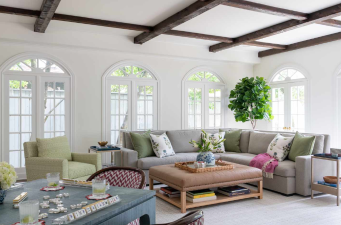How to Renovate Your Living Room for Cozy Vibes
Living room decoration is the most crucial aspect of any renovation. Its style can highlight the owner's overall taste and artistic conception. As a place for meeting and gathering, the living room's space must be rationally allocated, coordinated, and unified, creating a spacious, bright, and expansive appearance.
There are three main principles for living room decoration:

- Clear Style
The living room is often the largest area in the home and is also open. When choosing a style, it's crucial to clearly define whether to choose traditional or modern, Chinese or Western. A consistent style is essential; avoid a mix of Chinese and Western styles.
The living room's ceiling, colors, and lighting should also complement the overall style of the room. Smaller decorative elements, such as calligraphy and paintings, artwork, and small accessories, can reflect the owner's refinement and taste. These considerations should be carefully considered during the decorating process to ensure a consistent style.
- Reasonable Zoning
Living rooms are frequently used, and some even serve as dining and study areas. Therefore, the layout must be rationally zoned. Leisure areas, such as those for watching TV or chatting, should be separated, while special function areas, such as dining and study areas, should also be clearly defined through lighting and decorative techniques to create a distinct hierarchy.
Of course, this can be achieved through carpeting, partitions, or furniture placement. However, it's important to avoid rigid divisions that make space feel cramped. It's best to combine soft and hard divisions to highlight smaller areas within the larger space.
- Highlight Key Points
The living room consists of the ceiling, floor, and four walls, with the walls often becoming focal points. However, when designing the walls, avoid focusing on all four. Focus on one wall, often called the theme wall, and keep the other three walls simple. This way, you can highlight the key points and create the finishing touch.
Tips:
When designing and decorating the living room, ensure that there is ample light and avoid obstructions. Also, avoid choosing too dark a color for the walls, as this can create an uncomfortable impression.
Add some variety to your living room walls
Compared to traditional living room decor, modern decorating emphasizes a more prominent theme rather than clean, white walls. Therefore, when decorating, consider adding some elements to enrich your walls. What are some specific ways to do this?
- Photo Wall
For young families, a photo wall can be placed behind the sofa, behind a sofa, on a series of framed photos. These photos can be arranged in a variety of shapes and sizes. Paint the wall in light beige, light blue, or another pastel color. This will add variety and create a warmer, more inviting atmosphere.
- Wall Tiles
Most families don't tile their living room walls. However, if you're decorating a plain TV wall, you can add some spruce up the otherwise dull look with wall tiles. Glazed tiles with rich patterns can be particularly effective. Tips:
When laying wall tiles, consider the overall design and avoid overly rich, stark patterns.
- Murals
For rooms seeking a minimalist effect, the living room's main wall can be kept simple. A few murals, simple designs, or a large abstract painting or tapestry can maintain the integrity of the style and highlight individuality. These are good choices.
- Wallpaper
Wallpaper is also a great choice for living room walls. It's not only environmentally friendly but also comes in a variety of colors and styles. Choose the right wallpaper based on the overall decor. Of course, it's best not to cover the entire wall with wallpaper, as this can create a depressing effect without highlighting the main feature.
- Decorative Shelves
To add a sense of dimension and depth to a particular wall, usually the one behind the sofa, use decorative elements or simple shelves to accentuate the wall. This creates a modern, lively, and richer effect. This is also a good option.

Customizing Sofas According to Living Room Size
Generally, sofas sold on the market are manufactured according to specified dimensions. However, since every living room is different, it's best to order a sofa tailored to your living room's dimensions. Of course, it should also suit your overall decor and personal sitting habits. So, how can you customize a sofa based on the size of your living room?
- Small Living Room
Some living rooms may not exceed 60 square meters, and living rooms are often only a dozen square meters. In this case, you should customize a smaller, split-body sofa that can be moved and combined freely. The total number of sofas should not exceed three, and the backs should not be too high, so as not to make the small room look too crowded.
- Medium Living Room
For slightly larger living rooms, perhaps around 20 square meters, it's best to choose a moderately sized two- or three-person sofa. Alternatively, you can choose a split-body sofa with a moderately sized back and not too high. You can create a "1+3" or "2+3" sofa combination based on the size of the living room for a more harmonious overall look.
- Large Living Rooms
For larger living rooms exceeding 30 square meters, consider custom sofas. Choose larger, longer sofas to avoid creating a fragmented look by placing separate pieces. Avoid sofas with too low backs, which can create a spacey living room.


